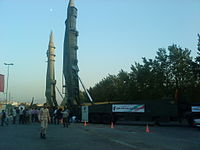Sejjil
| Sejil | |
|---|---|
 | |
| Type | Medium Range Ballistic Missile |
| Place of origin | Iran |
| Service history | |
| In service | In service as of 2014 |
| Used by | Iran |
| Production history | |
| Manufacturer | Iran |
| Specifications | |
| Mass | 22.5 tonnes[1] |
| Length | 18.2 m[1] |
| Diameter | 1.25 m[1] |
| Warhead weight | 500-1,500 kg[2] |
| Propellant | Solid fuel |
Operational range | 2,000[3]-2,500 km[1][4] |
Launch platform | Mobile launcher[5] |
Sejil, or Sejjil, (
liquid-fueled ballistic missiles. According to US Pentagon sources, the missile profile of the Sejil closely matches those of the Ashura, Ghadr-110 and the Samen.[5]
Design
According to
ICBM) capabilities ..."[6]
The missile utilizes composite solid fuel and unlike the Shahab-3 medium-range ballistic missile (MRBM), which is launched only vertically, the Sejil could be launched at a variable angle.[7] As a weapon, Sejil presents much more challenge to Iran's potential enemies, as solid-fuel missiles can be launched with much less notice than liquid-fueled missiles, making them more difficult to strike prior to launch.[8]
Iran claims that if launched from the city of Natanz, it could reach Tel Aviv in less than seven minutes.[9]
Variants
- Sejil-1: The Sejil is a two-stage, solid-propellant, surface-to-surface missile (SSM) produced by Iran with a reported 2,400 km (1,500 mi) range. [1] A successful test launch took place on 13 November 2008. Its range, if confirmed, would allow it to strike targets as far away as Israel and southeastern Europe.[10]
- Sejil-2: According to CSIS Missile Threat, it is unclear if there is an independent Sejil-2 variant, or whether the name is simply a reference by Iran to testing in 2009 of the original Sejil. [2]
- Sejil-3: According to CSIS Missile Threat, unconfirmed reports about the development of a Sejil-3 state that it would reportedly have three stages, a maximum range of 4,000 km, and a launch weight of 38,000 kg.[2]
- Sejil-2 missile images
-
Artist's impression
-
Sejil (right) and Qiam (left) missile
See also
- Military of Iran
- Iranian military industry
- List of military equipment manufactured in Iran
- Iran's missile forces
- Fateh-110
- Equipment of the Iranian Army
- Science and technology in Iran
External links
References
- ^ a b c d e f Theodore Postol (31 May 2009). The Sejil Ballistic Missile (PDF) (Report). Massachusetts Institute of Technology. Archived from the original (PDF) on 3 February 2013. Retrieved 14 September 2012.
- ^ a b c "Sejjil | Missile Threat | CSIS Missile Defense Project". Missile Threat.
- ^ BALLISTIC AND CRUISE MISSILE THREAT nasic.af.mil
- ^ Sajjil/Ghadr-110 globalsecurity.org
- ^ a b "Iran Tests Second Solid-Fuelled Sejil Missile, Capable of 2,900 km". Defense Update. 2009-05-20. Archived from the original on 2009-05-23. Retrieved 2009-05-21.
- ^ "New missile marks 'significant leap' for Iran capabilities". Jane's Defence Weekly. 2008-11-14. Retrieved 2010-04-17.
- FarsNews. 2008-11-18. Archived from the originalon 2013-01-23. Retrieved 2012-05-23.
- ^ "Iran, U.S.: Missile Claims and BMD in Europe (pay site)". STRATFOR. 2008-11-12. Archived from the original on 2012-02-13. Retrieved 2010-02-09.
- ^ Israel accelerating Arrow-4, sensor development due to Iranian hypersonic threat. Breaking Defense. 15 November 2022.
- ^ "Iran tests new long-range missile". BBC. 2008-11-12. Retrieved 2008-11-12.


